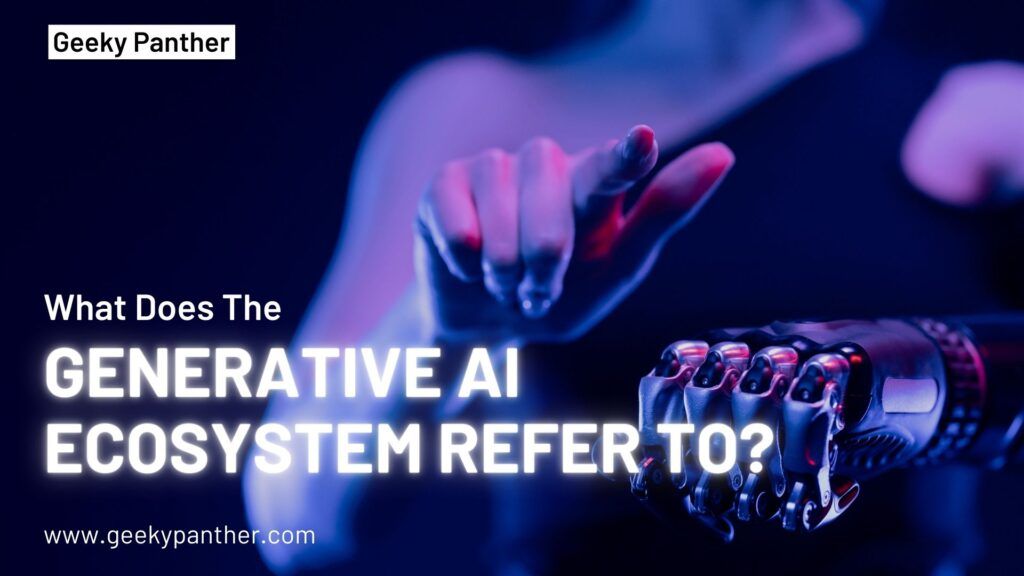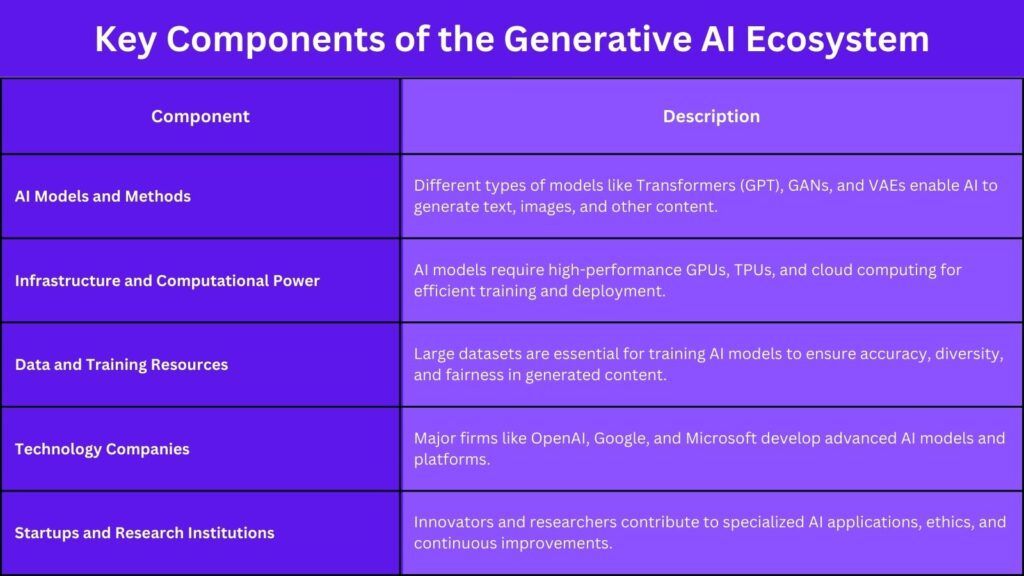Understanding What Does the Generative AI Ecosystem Refer to?
Imagine a world where computers can write stories, create beautiful artwork, or even compose music. That’s the magic of Generative AI! So, now the question is, what does the Generative AI ecosystem refer to?

Unlike traditional AI, which follows set rules to analyze data and provide answers, Generative AI creates something new—whether it’s text, images, or even voices. It learns patterns from vast amounts of data and then generates original content that feels human-like.
Generative AI is like a super-smart artist that studies millions of examples before making something unique. For example, an AI trained in thousands of books can generate new stories or articles, just like a human writer. In the same way, an AI trained on millions of images can create entirely new paintings, illustrations, or even realistic photographs that never existed before. This ability makes Generative AI incredibly powerful and useful in different industries.
Historical Development: What Does the Generative AI Ecosystem Refer to?
Generative AI has been around longer than you might think. Early versions date back to simple chatbots in the 1960s, like ELIZA, which could mimic human conversation. However, it was quite limited and worked only by following predefined rules.
In the 2010s, AI took a major leap with deep learning. This allowed AI to process massive amounts of data and learn patterns in a way that was much closer to how humans learn. OpenAI’s GPT series, Google’s Bard, and tools like Midjourney and DALL-E have brought generative AI into the mainstream. These tools can now create realistic text, images, and even videos, making them useful for businesses, artists, and everyday users.
Components of the Generative AI Ecosystem
When people ask, what does the Generative AI ecosystem refer to, they usually mean the network of models, data, and technologies powering AI-generated content. Generative AI relies on several key components.
AI Models and Methods
What does the Generative AI ecosystem refer to in modern industries, and how is it shaping businesses worldwide? The brain of Generative AI lies in different types of models, including:
- Transformers (like GPT) – These are used for text generation. They power chatbots and content-writing tools.
- GANs (Generative Adversarial Networks) – These create images, videos, and realistic artwork by having two AI systems compete against each other to improve results.
- VAEs (Variational Autoencoders) – These are used for AI-based creativity, such as designing new products or editing photos intelligently. Each model type has its own strengths, making AI diverse in its applications.
Infrastructure and Computational Power
If you’re wondering, what does the Generative AI ecosystem refer to, it includes AI models, infrastructure, key players, and ethical considerations. AI models need a huge amount of computing power. Companies use cloud computing, GPUs (Graphics Processing Units), and TPUs (Tensor Processing Units) to train and run AI models efficiently. Without this infrastructure, we wouldn’t have AI models capable of handling complex tasks. These models require enormous amounts of energy and computational power, making them expensive to train and run.
Data and Training Resources
AI is only as good as the data it learns from. Training a model requires enormous datasets—think billions of text documents, images, and even voice recordings. The quality of this data impacts the accuracy and usefulness of AI-generated content. If an AI is trained on biased or incorrect data, it can produce misleading or low-quality results. This is why companies invest in high-quality, diverse, and well-labeled datasets.
Key Players in the Generative AI Ecosystem
Here are some key players that contribute to the Generative AI ecosystem:
Technology Companies
Big tech companies are leading the AI revolution. OpenAI, Google, Meta, Microsoft, and Amazon are constantly pushing the boundaries of what AI can do. They develop advanced models and provide platforms for businesses and individuals to use AI technology. These companies also make AI tools more accessible by integrating them into everyday applications, like search engines, social media, and customer service chatbots.
Startups and Research Institutions
Startups are also making significant contributions, creating specialized AI tools for industries like healthcare, marketing, and education. Research institutions and universities play a major role in refining AI ethics, improving model accuracy, and ensuring AI is developed responsibly.
Applications of Generative AI
Generative AI is everywhere, from creative industries to business automation.
Industry-Specific Use Cases
Before diving into AI development, it’s essential to understand what does the Generative AI ecosystem refer to and its core components.
- Healthcare – AI helps in drug discovery, medical research, and even patient diagnostics. AI-powered systems assist doctors in identifying diseases from medical images like X-rays and MRIs.
- Finance – Banks use AI for fraud detection and personalized financial planning. AI also helps automate financial reports and analyze market trends.
- Marketing – AI writes ad copies, generates product images, and optimizes campaigns to reach the right audience.
- Entertainment – AI is used in movies and video games to create realistic animations, generate scripts, and even compose music.
Creative and Content Generation
What does the Generative AI ecosystem refer to in terms of its impact on creativity and automation?
- Art & Design – AI tools like Midjourney and DALL-E create stunning digital artwork based on text descriptions.
- Writing – AI can generate blog posts, news articles, and even fiction. Some authors are using AI to assist in brainstorming and structuring stories.
- Music & Audio – AI-generated music is being used in commercials, games, and streaming platforms. AI can also clone voices to create personalized voice assistants.

Challenges and Ethical Considerations
With great power comes great responsibility. Generative AI also has challenges.
AI Hallucinations and Accuracy Issues
AI sometimes generates false or misleading information, known as “hallucinations.” This can be problematic, especially in fields where accuracy is crucial, like healthcare or law.
Data Security and Privacy Risks
Since AI models require vast amounts of data, privacy is a big concern. Businesses and individuals must ensure that sensitive data is protected and not misused.
AI Plagiarism and Ethical Concerns
Generative AI can mimic human creativity, but where do we draw the line between inspiration and plagiarism? Many artists and writers worry that AI-generated content could undermine human originality.
User Spoofing and Fake Content
AI can create deepfakes—highly realistic fake videos or images. This can be misused to spread misinformation, manipulate public opinion, or commit fraud.
Economic and Social Implications
Economic Impact
Generative AI is transforming businesses, making work more efficient. However, it also raises concerns about job displacement, as automation takes over tasks once done by humans.
Sustainability and Environmental Considerations
Training AI models consume a massive amount of electricity. As AI continues to evolve, companies need to find ways to make AI more energy-efficient and sustainable.
Future Trends and Challenges
Technological Advancements
The next frontier for Generative AI includes:
- Multimodal AI – AI that can understand and generate multiple types of content, like text, images, and audio.
- Better personalization – AI that adapts to user preferences more accurately.
- General AI – Moving towards AI that can think and reason like humans.
Regulatory and Policy Issues
Governments are now stepping in to regulate AI usage, ensuring ethical practices and protecting individuals from potential AI misuse. As AI grows, so will policies governing its use.
Conclusion: What Does the Generative AI Ecosystem Refer to?
We hope your doubt regarding what does the Generative AI ecosystem refer to, and how does it influence content generation and innovation is clear. The Generative AI ecosystem is a quickly changing scenario with endless possibilities. From helping businesses automate tasks to revolutionizing creative industries, its impact is undeniable. However, it also presents challenges—ethical, economic, and environmental—that we must address. As we move forward, balancing innovation with responsibility will be key to unlocking the true potential of Generative AI.

